I guess when you get older people ask you this question. I had a friend ask that last night. I don't tend to think in those terms. But what the heck?
I surprised her in saying I didn't think it was would be reflexology exactly. Rather I felt it would be helping shift the medical paradigm from a strictly allopathic model to a model that focused on the reflex.
The one thing that fields like reflexology have that medicine doesn't is a basic unit of behavior or change. That is why medical texts are usually quite large. The medical field combines many different technologies hence the large texts.
I am very fond on the quote," All acts of life both conscious and subconscious are reflexes." It was Pavlov's teacher who said this.
The term, "reflexology" is actually Russian in origin. It was Pavlov's rival, Bechterev, who coined this term in 1917.
If you look out "reflexology" in the older dictionaries you might find the original definition which is "behavior of the reflexes". The Russians saw health as a behavior. And they felt that illnesses were the reflexes behaving badly.
At this point in history medicine isn't meeting our needs. It is costly, not very effective for chronic degenerative diseases and it can inadvertently kill you.
My legacy (I hope) will be to point healthcare in a direction that will view illness as reflexes gone bad that can be coaxed back into functioning better rather than a battlefield where the cure is frequently more harmful than the disorder.
All about reflexology from authors Barbara and Kevin Kunz. "Barbara and I have written 20 books on reflexology in 22 language editions with 58 foreign editions. We have been doing reflexology for over 35 years."
Monday, December 19, 2011
Thursday, December 15, 2011
Secret to developing new reflexology techniques
Here's the secret of how I develop new techniques. When I come up with a new technique I use a sequence to try it out. First I test the foot by rotating it. Then I apply the new technique. Next I test it by again by rotating the ankle. Finally I analyze it, often with the client's input. So it is test-operate-test-evaluate. I use it with regular technique as well. It is called the "tote" formula.
If the technique is successful the muscles relax. There are 4 major muscle groups coming down from the leg. These muscles effect the tension level in the foot. Rotation gives you a pretty good idea of how much effect the technique has had. As far as feedback it comes in second to what your client says.
The "killer" combination is to do the TOTE formula and then get them up and walking after one foot. If the techniques are effective they are amazed at the difference.
Oh and this works to test your current techniques as well.
If the technique is successful the muscles relax. There are 4 major muscle groups coming down from the leg. These muscles effect the tension level in the foot. Rotation gives you a pretty good idea of how much effect the technique has had. As far as feedback it comes in second to what your client says.
The "killer" combination is to do the TOTE formula and then get them up and walking after one foot. If the techniques are effective they are amazed at the difference.
Oh and this works to test your current techniques as well.
Wednesday, December 14, 2011
How can a reflexologist up their game?
We have been having an interesting discussion on the economic times and the resulting hard economic times for reflexologists. People are taking their lumps even though they are doing a good service.
So how do you survive in a harsh climate like this. You need to up your game. Pull out all the stops in becoming a better reflexologist. Here are some ideas. What are yours?
Stress cues- learning to read feet and hands will be critical in the next few years.
Instructional self help- with the need for speed in getting your client to their goals self help will be critical to the mission.
Fast foot loosening techniques- the reflexologist needs to demonstrate a change to their clients and quickly. Fast loosening techniques demonstrate that to them.
New techniques aimed at faster results- Tradition can stand in the way of new techniques. Reflexology needs to be a constantly evolving field. Also it needs discipline to prevent chaos.
Research- we need to demonstrate that there are real things happening in reflexology session. This is where research comes in. Being able to at least cite research is very important in building credibility.
Vocabulary aimed at professionalism- words matter and they set the stage for professionalism. Use them wisely.
Self help reflexology experiences you can call on- reflexologists need to practice what they preach. In instructing clients in self help it becomes more practical and less theoretical when you are practicing reflexology on yourself.
Strategies both for technique applications and for self help instruction- to me I am constantly working on strategies to reach the client's goal. My mistake in the past has been trying to reach my goals and not their goals.
I am going to break down and discuss these points in the coming weeks.
So how do you survive in a harsh climate like this. You need to up your game. Pull out all the stops in becoming a better reflexologist. Here are some ideas. What are yours?
Stress cues- learning to read feet and hands will be critical in the next few years.
Instructional self help- with the need for speed in getting your client to their goals self help will be critical to the mission.
Fast foot loosening techniques- the reflexologist needs to demonstrate a change to their clients and quickly. Fast loosening techniques demonstrate that to them.
New techniques aimed at faster results- Tradition can stand in the way of new techniques. Reflexology needs to be a constantly evolving field. Also it needs discipline to prevent chaos.
Research- we need to demonstrate that there are real things happening in reflexology session. This is where research comes in. Being able to at least cite research is very important in building credibility.
Vocabulary aimed at professionalism- words matter and they set the stage for professionalism. Use them wisely.
Self help reflexology experiences you can call on- reflexologists need to practice what they preach. In instructing clients in self help it becomes more practical and less theoretical when you are practicing reflexology on yourself.
Strategies both for technique applications and for self help instruction- to me I am constantly working on strategies to reach the client's goal. My mistake in the past has been trying to reach my goals and not their goals.
I am going to break down and discuss these points in the coming weeks.
Tuesday, December 13, 2011
Save your feet during the holidays
All the stress and rush of the holidays can really cause your feet and your body to ache for January. There are some simple tricks that can sooth your soles and your weary body.
1. Never stand still. Standing for long periods of time is very stressful. So rock gently side to side. If you are waiting in line sway gently side to side. Most other shoppers won't notice. One of my clients has her whole kitchen rocking side to side.
2. Interrupt stress and do it frequently. Stress won't kill you. What will kill you is uninterrupted stress. So take a break or several breaks throughout the day.
3. Roll your feet during those breaks with a simple foot roller. Rollers are a cheap way to break up the pattern of stress that forms during the holiday rush.
4. Wear good shoes. Think of shoes as tools for your feet. Good tools result in good results. High heels are asking for trouble. But you know that!!!
5. See a reflexologist. Hey give your feet a treat for the holidays. You are worth it, aren't you?
What are your tips for a happy and pain free holiday?
Are you focused with your reflexology work?
That brings up the idea of focus. Are you focused on your client? Is your first priority their feet or hands or do you find yourself caught up in the conversation you are having? Are you figuring out the best combination of techniques for that individual? Are you a problem solver thinking through a problem instead of delivering the same session each time for everybody?
These economic times and the reflexologist
I have been thinking a lot about reflexology's future in these tough economic times. I recently worked on an 84 year old with painful feet. In one session I was able lessen her pain quite a bit. But the astonishing part was she was able to walk as her husband put it "everywhere". She was able to shower on her own and even make it up and down short flights of stairs.
The point is instead of expecting to do a series of reflexology sessions are we going to have to produce results immediately to hold a client. With these economic times people seem less willing to wait for results. Every session now needs to be the best session you have ever produced.
The point is instead of expecting to do a series of reflexology sessions are we going to have to produce results immediately to hold a client. With these economic times people seem less willing to wait for results. Every session now needs to be the best session you have ever produced.
Tuesday, November 29, 2011
Age appropriate reflexology
Years ago I was talking to Robert St. John. He made an interesting comment on working on the aged. His question was simple. How much do you put an older person through?
I was working on an 84 year old yesterday. That question crossed my mind. Clearly there were very distinctive stress cues.
Aggressively pursuing them would have caused her a great deal pain. So instead I went for a relaxation effect. She fell asleep about half way through the session.
Was this the way to go? I think so. "Going for it" could have triggered more of a "fight or flight" reaction. This could have been a negative stressor on a already difficult situation.
I was working on an 84 year old yesterday. That question crossed my mind. Clearly there were very distinctive stress cues.
Aggressively pursuing them would have caused her a great deal pain. So instead I went for a relaxation effect. She fell asleep about half way through the session.
Was this the way to go? I think so. "Going for it" could have triggered more of a "fight or flight" reaction. This could have been a negative stressor on a already difficult situation.
Tuesday, September 27, 2011
Takefumi – Japanese Bamboo Foot Massager
Stepping on bamboo, called "takefumi" in Japanese ("ta-ke" means bamboo and "fumi" means to step upon), is a very popular and unique form of maintenance exercise that is being practiced in Japan, China, and Korea, for centuries.
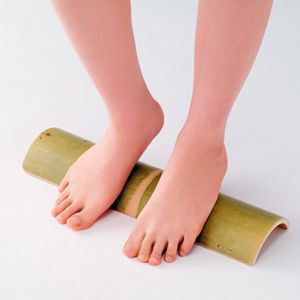
A simple bamboo piece split in half is used as a tool for takefumi. Almost every Japanese home has one.
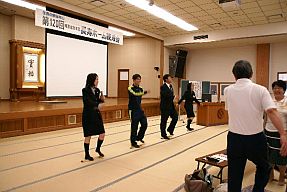
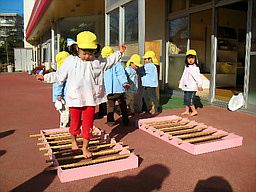
Schoolchildren doing takefumi.
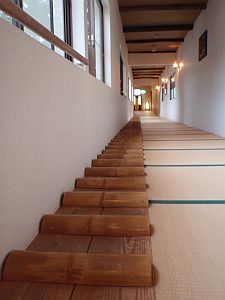
A pathway of takefumi prepared along the corridor of the school.
According to a century-old traditional medical knowledge, takefumi can remarkably remedy a variety of illnesses such as frozen shoulder, back pain, cramps, numbness, hypertension, constipation, insomnia, depression, urinary trouble, atopy, and tinnitus.
How to Perform Takefumi Exercise
The takefumi Japanese bamboo foot massager is very easy to use. Simply place it on the floor with the rounded side up and stand on it. Then, work your feet back and forth to massage all areas of your feet.
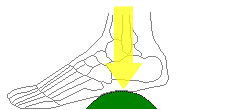
How Does Takefumi Work
Our feet are being compressed by the forces of gravity all day long and somewhat creates a pattern of stress. This pressure challenges the muscles and bones of your feet and if it continues, it can cause the bones to become misaligned, nerves to become irritated, and muscles will begin to weaken. This effect can impact other muscular-skeletal parts of your body. Walking on bamboo helps decompress your feet and pushes it back into shape. These are the simple fundamentals of takefumi.
You may get healthier and may live even longer, and you might forget your problems. Of course, you need to continue doing this to see good results—let's say for three months. You may get instant results whether it's a simple back pain, shoulder pain, or stiff neck and shoulders. Try it! You won't lose anything.
IMPORTANT TIP: It is better to use green bamboo of about one to two years old. Why? Young bamboo tree is capable of absorbing energy from its surroundings, and the energy will reflect in healing or correcting your health condition.
To prove it, notice how the snow melts around the trees when spring comes.
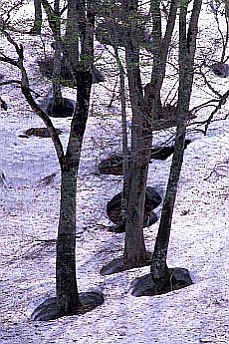
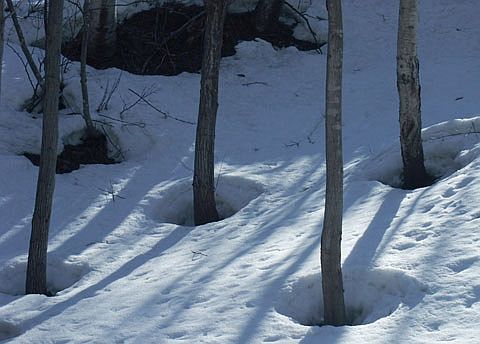
There are several explanations to this. One, the heat from the sun has accumulated within the tree. Second, our findings show that a young tree radiates infrared rays and other unknown energies, causing the snow to melt.
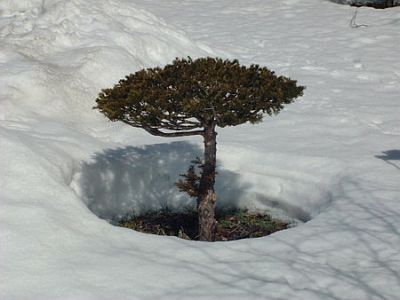
I remember that an old Chinese medical book states that a green young bamboo tree has healing power when you step on it.
Reflexology Paths
Aside from the takefumi, there is another century-old practice called "stone stepping" as seen in the photos below.
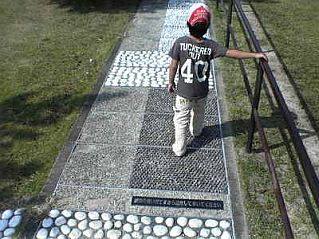
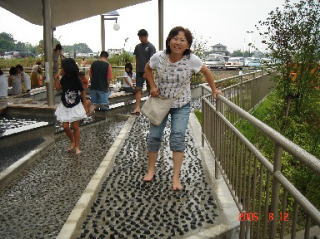
These are special paths (more often called the "Reflexology Path") that are made of pebbles where you walk barefooted around the pebble path.
You may think that this can be done very easily, but in reality, it's not. You will feel pain the first time you do it. Of course, later on you can get the same result as takefumi.
Conclusion
The takefumi "stepping upon bamboo" exercise can help revitalize your bone, muscle, blood vessels, nerves, and other related parts of your body.
It is recommended that you perform this exercise 2 to 3 times a day with a total of about 180-200 or even 300 steps. Of course, the most important thing to remember is to continue doing it for lifetime. Also count out "one, two, three..." loudly while doing the exercise. It will help a lot, and won't even cost you a cent.
Yes, a lot of people ask how to cure or heal their illnesses. We like to advise you that you should do some exercises such as the "takefumi" or walking on a "pebble path" to build healthy body and avoid contracting incurable diseases beforehand.
We, the PYRO-ENERGEN staffs are all healthy. Of course, sometimes, we catch a cold, but it's a simple common cold that lasts for a few days only. Most of us have been together for more than 30 years and some are over 40 years, and none of them suffered from any serious illness. Amazing? That's because we all do good works!
About the Author:
Junji Takano is a Japanese health researcher involved in investigating the cause of many dreadful diseases. In 1968, he invented PYRO-ENERGEN, the first electrostatic therapy device for electromedicine that effectively eradicates viral diseases, cancer, and diseases of unknown cause.
Click here to find out more: http://www.pyroenergen.com/about.htm
Free health newsletter: http://www.pyroenergen.com/newsletter.htm
Click here to find out more: http://www.pyroenergen.com/about.htm
Free health newsletter: http://www.pyroenergen.com/newsletter.htm
------------------------------------------------------------
Friday, August 26, 2011
Stand up for longevity
Pilates and yoga are up and we’re all sitting down too much. Two seemingly disparate items from the news this week actually converge on one idea. And the feet and reflexology are in the mix too.
So, what am I on about? Here’s the news: We sit too much while watching television and it’s impacting our health and longevity. A study has shown that for every one hour of television watched, 22 minutes of one’s life is lost. According to Australian researchers, reporting numbers that are comparable to previous studies, those who watch 6 hours of television a day can expect to live 4.8 years less when compared those who do not watch not television.
In other news, the Wall Street Journal is reporting that yoga and Pilates studios are a good investment for the future, considering their increase in sales and profits over the past five years.
The idea that binds the two reports? The exercise or lack of exercise of postural muscles, the muscles of the body that hold us upright as we walk and stand. Sitting too much, for example, while watching television incapacitates the body’s postural muscles. These muscles are tied into the body’s internal mechanisms that create cardio-vascular disease, diabetes and obesity. Failure to give these muscles enough of a workout, the net result of prolonged sitting, creates a greater risk of these and other health problems as well as a decrease in longevity.
Where do postural muscles fit into yoga, Pilates and, yes, reflexology? The exercise of postural muscles is what these practices are all about.
The goal of Pilates is the strengthening of the core—or postural muscles. Yoga? Activation of postural muscles through its exercises. Reflexology? Reflexology’s techniques apply pressure to feet—a key signal we’re not sitting and central to postural muscle activation. Reflexology provides what may be a bit of a trompe l’oeil. While the artist’s technique fools the sensory receptors in the eye about what is being seen, the reflexologist’s work fools the pressure sensors in the feet about whether postural muscles activated. The nervous system is, thus, tricked into its estimation about activities of the postural muscles and the commiserate internal mechanisms. And, yes, research demonstrates that reflexology effects, among other things related to postural muscles, measures of cardio-vascular system and those related to diabetes.
So what’s with this increase in sales at yoga and Pilates studios and will reflexology as an investment opportunity be far behind? First, popularity translates into sales. It’s all about people responding to what their bodies need, a workout of the postural muscles. This is known as an archestructure, an innate drive to meet the physical needs of the body or “a felt or perceived function or structural feature of the nervous system, projected or unconsciously acted out in the life-style or the beliefs, customs and social structure s of the individuals concerned or of whole communities.” (Gooch, Stan F. Total Man, Ballantine Books, 1972, p. 299) Yoga, Pilates and reflexology enthusiasts are responding to something their bodies need by participating in what is, in essence, postural muscle exercise.
Next: when will investment come to the reflexology industry? Reflexology has already increased in popularity in many Western countries but if we lived in the Far East, we’d be looking at the explosive growth of a reflexology industry. Frankly, the only thing holding it back in the West is what one author refers to as traditions and expectations of how health happens. In the Far East, reflexology is a star.
It is estimated that 4 million Chinese provide reflexology services with the government seeing a shortage and calling for another million. The reflexologists practice at reflexology “parlors,” some chains with as many as 700 locations. Then, there are the medical practitioners of reflexology with “first class” reflexology licenses issued by the government working in clinics and hospitals. (By the way, the inclusion of reflexology in medicine is based on research. Consider the research monies spent to position the Chinese as world leaders in reflexology research, with hundreds if not thousands of studies that would meet NIH standards.)
Then there are the reflexology paths, special cobblestoned sidewalks, in parks where senior citizens line up twice a day to walk, considered to be a “fashionable fitness activity.” (Aside from traditions of Tap Shek (stone stepping), the Chinese frequently quote a study by the Oregon Research Institute demonstrated the benefits to seniors of such “enhanced walking.”) Rock companies offer and sell specific stones to be used for paths at one’s home. The Chinese government is currently funding paths to be built in outdoor sports facilities across the country as a part of its 10-year Fitness Program. (Imagine the construction mini-industry of path building.) Then, there’s the industry of manufacturing and selling reflexology products—mats and sandals available at any and all pharmacies.
The same could be said about the reflexology industry in other Far East countries. It’s hard to imagine a condominium complex in Singapore, a city park in Seoul or a national park in Malaysia without a reflexology park. There are reflexology kiosks in shopping malls. Japanese tourists travel to Taiwan for their specific reflexology practitioners. A Shiseido factory in Japan has found the reflexology path use improves productivity and lessens medical bill for employees.
We leave you with this thought: stand up, America. Your health and longevity will be the better for it. (A minimum of every 30 minutes is suggested by researchers) And, oh yeah, if you want to super-charge things, think yoga, Pilates and reflexology.
Barbara and Kevin Kunz
So, what am I on about? Here’s the news: We sit too much while watching television and it’s impacting our health and longevity. A study has shown that for every one hour of television watched, 22 minutes of one’s life is lost. According to Australian researchers, reporting numbers that are comparable to previous studies, those who watch 6 hours of television a day can expect to live 4.8 years less when compared those who do not watch not television.
In other news, the Wall Street Journal is reporting that yoga and Pilates studios are a good investment for the future, considering their increase in sales and profits over the past five years.
The idea that binds the two reports? The exercise or lack of exercise of postural muscles, the muscles of the body that hold us upright as we walk and stand. Sitting too much, for example, while watching television incapacitates the body’s postural muscles. These muscles are tied into the body’s internal mechanisms that create cardio-vascular disease, diabetes and obesity. Failure to give these muscles enough of a workout, the net result of prolonged sitting, creates a greater risk of these and other health problems as well as a decrease in longevity.
Where do postural muscles fit into yoga, Pilates and, yes, reflexology? The exercise of postural muscles is what these practices are all about.
The goal of Pilates is the strengthening of the core—or postural muscles. Yoga? Activation of postural muscles through its exercises. Reflexology? Reflexology’s techniques apply pressure to feet—a key signal we’re not sitting and central to postural muscle activation. Reflexology provides what may be a bit of a trompe l’oeil. While the artist’s technique fools the sensory receptors in the eye about what is being seen, the reflexologist’s work fools the pressure sensors in the feet about whether postural muscles activated. The nervous system is, thus, tricked into its estimation about activities of the postural muscles and the commiserate internal mechanisms. And, yes, research demonstrates that reflexology effects, among other things related to postural muscles, measures of cardio-vascular system and those related to diabetes.
So what’s with this increase in sales at yoga and Pilates studios and will reflexology as an investment opportunity be far behind? First, popularity translates into sales. It’s all about people responding to what their bodies need, a workout of the postural muscles. This is known as an archestructure, an innate drive to meet the physical needs of the body or “a felt or perceived function or structural feature of the nervous system, projected or unconsciously acted out in the life-style or the beliefs, customs and social structure s of the individuals concerned or of whole communities.” (Gooch, Stan F. Total Man, Ballantine Books, 1972, p. 299) Yoga, Pilates and reflexology enthusiasts are responding to something their bodies need by participating in what is, in essence, postural muscle exercise.
Next: when will investment come to the reflexology industry? Reflexology has already increased in popularity in many Western countries but if we lived in the Far East, we’d be looking at the explosive growth of a reflexology industry. Frankly, the only thing holding it back in the West is what one author refers to as traditions and expectations of how health happens. In the Far East, reflexology is a star.
It is estimated that 4 million Chinese provide reflexology services with the government seeing a shortage and calling for another million. The reflexologists practice at reflexology “parlors,” some chains with as many as 700 locations. Then, there are the medical practitioners of reflexology with “first class” reflexology licenses issued by the government working in clinics and hospitals. (By the way, the inclusion of reflexology in medicine is based on research. Consider the research monies spent to position the Chinese as world leaders in reflexology research, with hundreds if not thousands of studies that would meet NIH standards.)
Then there are the reflexology paths, special cobblestoned sidewalks, in parks where senior citizens line up twice a day to walk, considered to be a “fashionable fitness activity.” (Aside from traditions of Tap Shek (stone stepping), the Chinese frequently quote a study by the Oregon Research Institute demonstrated the benefits to seniors of such “enhanced walking.”) Rock companies offer and sell specific stones to be used for paths at one’s home. The Chinese government is currently funding paths to be built in outdoor sports facilities across the country as a part of its 10-year Fitness Program. (Imagine the construction mini-industry of path building.) Then, there’s the industry of manufacturing and selling reflexology products—mats and sandals available at any and all pharmacies.
The same could be said about the reflexology industry in other Far East countries. It’s hard to imagine a condominium complex in Singapore, a city park in Seoul or a national park in Malaysia without a reflexology park. There are reflexology kiosks in shopping malls. Japanese tourists travel to Taiwan for their specific reflexology practitioners. A Shiseido factory in Japan has found the reflexology path use improves productivity and lessens medical bill for employees.
We leave you with this thought: stand up, America. Your health and longevity will be the better for it. (A minimum of every 30 minutes is suggested by researchers) And, oh yeah, if you want to super-charge things, think yoga, Pilates and reflexology.
Barbara and Kevin Kunz
Wednesday, August 17, 2011
Kevin goes to the hospital—stories from the reflexologist at the foot of the hospital bed
Remembering back to my first reflexology hospital call—the client who had undergone surgery for stomach stapling due to morbid obesity—I wasn’t aware as I rolled the chair up to the foot of the bed after his surgery that his doctor had given him a 50-50 chance of surviving. His aunt was there, the loving relative who was also a nurse, watching my every move. She liked me personally but didn’t think too much of that “reflexology stuff”.
All I can say about her attitude is—the next time I visited, she rolled the chair up to the bed and folded back the covers. It turned out she had been monitoring his vital signs and they had improved after my previous visit. Dick survived the surgery and lived for another 20 years.
The point is that Dick needed the stomach stapling operation. But that very same operation could have killed him. Reflexology acted to be like a life perserver until his body could respond and normalize. What happened with no official sanctioning was a hybrid of medicine and reflexology.
The next time I made a hospital call it was at the request of the head of the Nursing Department at Texas Tech University in Lubbock. One of her graduate nursing students was in CCU (Cardiac ICU) for a heart attack and the heart attacks were continuing—in the hospital. It was the first time I could watch the heart monitor as I worked. I could see her pulse rate decline from 140 bpm to 70. She was asleep when I left.
She did have a blocked artery and there was a heart bypass surgery performed. She needed the operation but the reflexology helped stabilize her prior to the surgery. The surgery had a positive outcome.
Then there was the time my father-in-law was in ICU with congestive heart failure. His heart refused to go into a regular heart beat and they wanted to cut him open to shock his heart, hoping it would go into sync—something he definitely did not want to happen. Two hours after I left, the nursing staff noticed his heart dropped back into a regular rhythm where it stayed. No surgery was required.
I used to call it under cover work, visiting the hospital to do reflexology and hiding my work. But things changed dramatically over the years.
Many years ago my 6 year-old grand nephew was in pediatric ICU with flesh-eating bacteria attacking the pericardium protecting his cardiac muscle (23 days I would not want to re-live). It was life threatening. I worked on him day and night fighting to keep him alive.
I always stopped my reflexology work when the staff came in so I wouldn’t be in the way. One time as the doctor was leaving after a visit, she turned around to say, "Be sure to work the lung area."
With that, I knew then that times had changed for reflexology visits to the hospital. By the way, Jakey just turned 21. He needed both medicine and reflexology to survive.
Maybe it is time to build a hybrid between what medicine does well and what reflexology does well. In all these cases these people needed medical attention. But there is no reason it has to "be either or" medicine. In fact it is more like the "best of both worlds" medicine.
You could say it is a medical hybrid of sorts.
Barbara and Kevin Kunz
You could say it is a medical hybrid of sorts.
Barbara and Kevin Kunz
Tuesday, August 16, 2011
Your Own Medical Hybrid: Reflexology and medicine
A hybrid of reflexology and medicine—an idea I like. And, as it turns out, it’s an idea that could work to help not only a loved one but also the health care budget.
What am I talking about?
Well, the medical community is starting to research and use reflexology, for example, post surgically—but it’s not yet available most places. So, I want to start my own medical hybrid with reflexology, helping friends and family as needed, working with assurance of positive results using the same research the medical community would use when it adopts reflexology.
The idea came to me as I was looking at exactly that—the research about reflexology undertaken for use within the medical community. What stood out were the number of studies for use of reflexology in medical facilities for patients in: post-operative recovery, labor/delivery/post partum care, and cancer care.
Hmmm, I thought, this sounds familiar. Been there, done that. Sitting in the hospital room, visiting a loved one just out of surgery, holding a hand—but really applying reflexology. So, now I’m looking at the research. What do I find? Reflexology helps post surgically with recovery, pain reduction, and lessened anxiety.
Hmmm, more thinking: What if everyone and anyone was reassured by research that he or she could help a loved one, providing reflexology and doing what the hospital would provide if only they had the money and knew about the research? What would it mean? Sitting helplessly by a hospital bed wanting to help would be a thing of the past? Money would be saved because hospital stays would be shortened?
It turns out I’m not the first to have this idea as shown by this on-line story. The individual wanted to help his friend be released from the hospital but first the patient had to defecate—standard for hospital release. He looked up a reflexology chart on-line, worked on his friend’s feet and, yes, the friend was released promptly. Exactly as the research had found—reflexology helps bowel and bladder functions return more quickly.
Barbara and Kevin Kunz
Barbara and Kevin Kunz
Monday, August 15, 2011
High Tech / High Touch: Medical Hybrid- Why medicine needs reflexology
Medicine is turning to reflexology to do what it can’t. It’s medicine as a hybrid—all the advantages of advanced science and targeted touch. It’s the best of both worlds to make medicine work, save money, and, oh yeah, get people well again. It doesn’t have to be "either-or medicine". The medical hybrid of medicine and reflexology just makes sense.
Research shows that, when the high tech of medicine isn’t enough, the high touch of reflexology helps. The value of reflexology in a medical setting, serving as an adjunct for patients post-surgically, is demonstrated by fifteen studies conducted in eight countries. And, it’s this research that shows both (1) why medicine needs reflexology and (2) what doors are opening for reflexology use in medical settings.
The studies show the value of reflexology as it helps with recovery from surgery, doing what medicine can’t: pain reduction when pain killing medicine isn’t enough; speedier wound healing; quicker restoration of bowel and bladder functions; and help to reduce anxiety, a common recovery-interfering post-surgical emotion. In addition to improving quality of life for patients and providing a possible intervention for nurses looking for solutions, such improvements thanks to reflexology have financial consequences: earlier discharge from the hospital as bowel and bladder functions return earlier as well as savings in the lessened use of pain medication.
The studies about the post-operative effects of reflexology work noted here were conducted in: China (6), Austria (3), Iran (1), UK (1), Korea (1), Taiwan (1), Thailand (2), and India (1).
Recovery
In six studies—three from China (pacemaker installation, abdominal and gynecological surgery) and two from Austria (unknown and abdominal surgery)—positive results are noted for post-operative foot reflexology application to enhance return of bowel and bladder functions earlier than those of the control groups. These functions are disrupted after surgery and necessary for discharge from the hospital.
Aside from patient quality of life, earlier discharge is a money-saving issue. Recovery results specific to the type of operation were reported for pacemaker installation (postoperative wound pain, “postural hypotension,” wound healing) and gastro-intestinal surgery (abdominal distension rate).
Aside from patient quality of life, earlier discharge is a money-saving issue. Recovery results specific to the type of operation were reported for pacemaker installation (postoperative wound pain, “postural hypotension,” wound healing) and gastro-intestinal surgery (abdominal distension rate).
In one study reported in the Journal of Nursing, Chinese researchers compared patients recovering from pacemaker installation, providing usual care to a control group and usual care plus foot reflexology to the another group. In reporting results, they found reflexology to be “conductive to improving the lives of patients’ quality, accelerated postoperative rehabilitation” specifically “postoperative wound pain, sleep time, constipation, postural hypotension, wound healing time was significantly different.” (1)
Mood / Anxiety / Quality of Life
Lessened depression and anxiety as well as improved quality of life (physical, social/family, emotional, and functional well-being) resulted from the application of reflexology post-surgically in two studies of abdominal surgery patients and one of breast cancer patients. Aside from emotional well-being, such psychological enhancement through reflexology work improves recovery from surgery.
As noted in one study: because “Anxiety is a common phenomenon after all surgical operation,” the effects of reflexology and relaxation techniques on reducing anxiety for women who had undergone abdominal surgery was studied by nurses on the Faculty of Nursing at the Baqiyatallah University of Medical Sciences, Tehran, Iran.
Three groups were included in the study: reflexology, relaxation and a control group. “Spielberger scale used to measure the anxiety and data analyzed by descriptive and analytic statistics.” A significant difference was found between the reflexology and control groups as well as the relaxation and control groups. The researchers “so recommended to use as complementary methods for decreasing anxiety.”
Three groups were included in the study: reflexology, relaxation and a control group. “Spielberger scale used to measure the anxiety and data analyzed by descriptive and analytic statistics.” A significant difference was found between the reflexology and control groups as well as the relaxation and control groups. The researchers “so recommended to use as complementary methods for decreasing anxiety.”
Pain
Pain reduction is a significant result of reflexology work in general as noted in some 35 studies. Ten of the studies have been conducted post-operatively. Lessened pain and/or a decrease in the amount of medication is reported post-surgically for mastectomy; abdominal surgery; gastric and liver cancer; prostatectomy; open heart and general surgery patients.
As noted in one study: even after receiving analgesia, patients with gastric and liver cancer still report moderate levels of postoperative pain. As reported in Cancer Nursing, Taiwanese nurses conducted a study of the use of reflexology to relieve pain and anxiety in postoperative patients with gastric cancer and hepatocellular cancer.
Less pain and anxiety were reported by reflexology group members when compared to those in the control group. In addition, “patients in the intervention group received significantly less opioid analgesics than the control group (P <.05). Findings from this study provide nurses with an additional treatment to offer postoperative digestive cancer patients.”
The Future
Doesn't it make sense to build a hybrid of Hi Tech (conventional medicine) and Hi Touch (reflexology, massage and so forth). What do you think?
Barbara and Kevin Kunz
Less pain and anxiety were reported by reflexology group members when compared to those in the control group. In addition, “patients in the intervention group received significantly less opioid analgesics than the control group (P <.05). Findings from this study provide nurses with an additional treatment to offer postoperative digestive cancer patients.”
The Future
Doesn't it make sense to build a hybrid of Hi Tech (conventional medicine) and Hi Touch (reflexology, massage and so forth). What do you think?
Barbara and Kevin Kunz
Thursday, August 11, 2011
Do you have a longer second toe? The Video
We have been talking about a longer second toe for years. Here is the video version. Enjoy!!!
Much of the world's population have longer second toes. Longer second toes are not a defect rather than are a genetic variant. If we were running around in the wild longer second toes wouldn't be much of a problem. Because of the modernization of the foot's environment with shoes and flat, hard surfaces the longer second toe has caused not only stress to the feet but also to the rest of the body as well.
This video is an explanation of a longer second toe plus some simple, cheap and effective solutions by Barbara and Kevin Kunz., authors of 18 books on reflexology in 20 languages.
Kevin Kunz
http://www.reflexology-research.com
Much of the world's population have longer second toes. Longer second toes are not a defect rather than are a genetic variant. If we were running around in the wild longer second toes wouldn't be much of a problem. Because of the modernization of the foot's environment with shoes and flat, hard surfaces the longer second toe has caused not only stress to the feet but also to the rest of the body as well.
This video is an explanation of a longer second toe plus some simple, cheap and effective solutions by Barbara and Kevin Kunz., authors of 18 books on reflexology in 20 languages.
Kevin Kunz
http://www.reflexology-research.com
Wednesday, August 10, 2011
Reflexology Jade Walking Blanket
So popular is reflexology mat walking in China that new products are constantly cropping up. We like the name of this cobblestone mat product—the Jade Walking Blanket. It combines reflexology Tap Shek (stone stepping) ideas with thoughts about the value of jade as a health enhancer.
It’s interesting to follow the development of the reflexology mat industry in China. It is a reminder of the value of the reflexology industry as a whole. Aside from mats, it is estimated that 4 million Chinese are employed at and provide reflexology services at small, one person reflexology businesses or at a reflexology “parlor” chain, with 700 locations across the country. Then, there are the medical applications of reflexology, carried out in clinics and hospitals by those with “first class” reflexology licenses issued by the government. (By the way, the government estimates it needs another 1 million reflexologists and is seeking to up-grade education for reflexologists.) Then, there is the industry of building reflexology paths. Rock companies offer and sell suggestions for stones to be used for paths at one’s home. The government is funding paths to be built in outdoor sports facilities across the country as a part of the country’s 10-year Fitness Program.
Reflexology mat use indoors grew with the popularity of reflexology paths in parks. The current use of “walking blanket” to describe a reflexology mat possibly started out with the manufacturer of the first mats, a blanket company. Plastic “pebbles” were embedded into felting, an existing product of the blanket company. This mat is widely used throughout China to experience the benefits of walking the reflexology path when it’s raining outside and paths in parks are not usable. It has been available for sale for years at pharmacies (drug stores) all over the country.
Points of importance to the consumer are reflected in advertising copy for the Jade Walking Blanket: “high-grade agate massage blanket / health trail walk / foot massage pad / pebble.… “This section walks away blankets, at the end of glue imported from Germany with a silicone medical environment, superior adhesion, non-toxic and tasteless, agate never fall, can be washed, … “Particularly highlighted: agate size specifications are recommended by experts, people step up, through its pressure on the plantar foot massage to stimulate acupuncture points, exactly in line with traditional Chinese medicine acupuncture massage pressure points, such as another bigger or smaller, simply not achieve the effect of massage points.”
Benefits of mat walking are: “Agate health walk blanket is based on science and health Foot health theory developed from jade. Foot health study it and study in one health and jade, agate natural stone instead of manpower through the body's own pressure, while walking on the foot pressure point massage therapy to acupuncture. And thus help promote blood circulation, strengthen the heart power. Adjusting the internal organs function, and enhance immunity. Eliminate fatigue, relieve stress, improve sleep quality foot health effects.”
Instructions are given about how to walk on the mat to achieve effects for specific health goals.
“Here are some more efficient use of walking blanket approach:
1, heart relaxed walk method: go easy on walking on the carpet. (Leisure and fitness)
2, focused massage the pain points of law: that is to go walking on the carpet and found that pain point, then focus on massage. (Health, physical therapy)
3, hands Paitui law: that is to go on a walking carpet, the order making the legs with both hands simultaneously forcing up the legs. (For arthritis, osteoporosis and other patients)
4, body tapping law: that is to go walking on carpet, use both hands free to beat the abdomen, chest and other parts, play the effect of relaxing the body. (Through the meridians)
5, four-step health law: that is to go walking on the carpet, the pleasant four-step jump, while meditation soles of the feet, soles of the feet. (For patients with hypertension and mental)”
Monday, August 8, 2011
Reflexology Golf Ball Technique
We call this technique the million dollar self help technique because it so valuable in helping a number of conditions like asthma, allergies, sinuses and digestive upset. And the best part is all you really need is a golf ball.
Barbara Kunz invented this. It is truly a simple way to do self help on your hands. We use it in all our self help books.
Kevin Kunz
http://www.reflexology-research.com
http://www.dk.com/reflexology
Tweet me @twitter.com/kevinkunz
Facebook www.facebook.com/kevin.kunz
Barbara Kunz invented this. It is truly a simple way to do self help on your hands. We use it in all our self help books.
Kevin Kunz
http://www.reflexology-research.com
http://www.dk.com/reflexology
Tweet me @twitter.com/kevinkunz
Facebook www.facebook.com/kevin.kunz
Thursday, July 28, 2011
It’s deja vu all over again
It’s deja vu all over again. An editorial about unnecessary professional licensing in the Wall Street Journal (July 28, 2011) brought back memories of all the battles fought over the years for the right to practice reflexology without massage licensing.
The general theme of the editorial is state regulation as a stumbling block to job creation. Cited as a prime example is hair braiding, an African “cultural art form.” The editorial notes the growth of hair braiding businesses in Mississippi which does not require cosmetology licensing as opposed to Florida where such licensing is required.
The authors of the editorial Chris Mellor and Dick Carpenter are president / general counsel and director of strategic research respectively of the Institute for Justice. The Institute won a battle for California hair braiders in 1999. “… the Institute for Justice in 1999 struck down California’s expansive, expensive and arbitrary cosmetology laws that had prevented hundreds of African-Americans (mostly women) from practicing a cultural art form: African hair braiding.… “California had required that African hairstylists spend nine months (1,600 hours) and at least $5,000 at a government-approved cosmetology school before sitting for the state licensing examination, which allowed braiders to legally practice their craft. But none of these government-mandated classes actually taught students how to braid hair. In fact, they taught techniques that were especially damaging to African hair.” (http://www.ij.org/index.php?option=com_content&task=view&id=835&Itemid=165)
“…none of these government-mandated classes actually taught students how to braid hair” Sound familiar? The same can be said for massage law requirements for reflexologists in New York, Florida, Louisiana, Hawaii, Nebraska, Alabama and Arkansas where state laws include government-mandated massage training but no reflexology education of reflexology practitioners. The one exception is Arkansas where 10 (?) hours of reflexology training is required during massage training. (Note: The states of Texas and New Hampshire are under contention currently.) Over the years, reflexologists have broken free from existing or pending massage licensing requirements in Illinois, New Mexico, North Carolina, North Dakota, Tennessee, Maryland, Oregon, Arizona, and Washington state as well as the cities of Denver and Colorado Springs.
Particularly noteworthy are requirements in the states of New York and Florida where large populations receive reflexology services provided by individuals with state-mandated massage licensing with no reflexology training required. In both states an outcry has been raised but in Florida, battles have raged for decades with the massage school owner dominated massage board as well as before the state legislature. LINK Both the reflexologist as a small business person and the idea have suffered as a result.
We fondly remember Bob whose reflexology clientele in the late 1970’s consisted of other residents of his Florida retirement village where he had a regular circuit of house calls. Would today’s residents receive such services? Perhaps by someone flying under the state’s massage law but otherwise the answer is most assuredly, no—the cost of the home call by a massage-licensed individual would undoubtedly be beyond the budgets of Florida retirement village seniors.
In New York City some years ago, Rockport wanted to hire reflexologists to promote its shoe line in shoe stores when it ran into a problem—they couldn’t find state-mandated massage practitioners who provided reflexology when “reflexology” services were requested—applicants for the job all practiced foot massage under the label of reflexology. Rockport dropped the idea.
The idea suffers as well. In the late 1990’s Barbara and Kevin Kunz were in discussion to conduct research with Dr. Oz at Columbia Presbyterian Medical Center in New York City. The Kunzes cautioned the Oz team about the licensing requirement and the research idea was dropped.
The general theme of the editorial is state regulation as a stumbling block to job creation. Cited as a prime example is hair braiding, an African “cultural art form.” The editorial notes the growth of hair braiding businesses in Mississippi which does not require cosmetology licensing as opposed to Florida where such licensing is required.
The authors of the editorial Chris Mellor and Dick Carpenter are president / general counsel and director of strategic research respectively of the Institute for Justice. The Institute won a battle for California hair braiders in 1999. “… the Institute for Justice in 1999 struck down California’s expansive, expensive and arbitrary cosmetology laws that had prevented hundreds of African-Americans (mostly women) from practicing a cultural art form: African hair braiding.… “California had required that African hairstylists spend nine months (1,600 hours) and at least $5,000 at a government-approved cosmetology school before sitting for the state licensing examination, which allowed braiders to legally practice their craft. But none of these government-mandated classes actually taught students how to braid hair. In fact, they taught techniques that were especially damaging to African hair.” (http://www.ij.org/index.php?option=com_content&task=view&id=835&Itemid=165)
“…none of these government-mandated classes actually taught students how to braid hair” Sound familiar? The same can be said for massage law requirements for reflexologists in New York, Florida, Louisiana, Hawaii, Nebraska, Alabama and Arkansas where state laws include government-mandated massage training but no reflexology education of reflexology practitioners. The one exception is Arkansas where 10 (?) hours of reflexology training is required during massage training. (Note: The states of Texas and New Hampshire are under contention currently.) Over the years, reflexologists have broken free from existing or pending massage licensing requirements in Illinois, New Mexico, North Carolina, North Dakota, Tennessee, Maryland, Oregon, Arizona, and Washington state as well as the cities of Denver and Colorado Springs.
Particularly noteworthy are requirements in the states of New York and Florida where large populations receive reflexology services provided by individuals with state-mandated massage licensing with no reflexology training required. In both states an outcry has been raised but in Florida, battles have raged for decades with the massage school owner dominated massage board as well as before the state legislature. LINK Both the reflexologist as a small business person and the idea have suffered as a result.
We fondly remember Bob whose reflexology clientele in the late 1970’s consisted of other residents of his Florida retirement village where he had a regular circuit of house calls. Would today’s residents receive such services? Perhaps by someone flying under the state’s massage law but otherwise the answer is most assuredly, no—the cost of the home call by a massage-licensed individual would undoubtedly be beyond the budgets of Florida retirement village seniors.
In New York City some years ago, Rockport wanted to hire reflexologists to promote its shoe line in shoe stores when it ran into a problem—they couldn’t find state-mandated massage practitioners who provided reflexology when “reflexology” services were requested—applicants for the job all practiced foot massage under the label of reflexology. Rockport dropped the idea.
The idea suffers as well. In the late 1990’s Barbara and Kevin Kunz were in discussion to conduct research with Dr. Oz at Columbia Presbyterian Medical Center in New York City. The Kunzes cautioned the Oz team about the licensing requirement and the research idea was dropped.
Friday, July 8, 2011
Free Friday- Free Reflexology Stuff- New Stuff
Free Friday- Free Reflexology Stuff
Free Technique Videos
*****************************************************************
****************************************************************
Special for 48 hours only!!
****************************************************************
Reflexologist’s eBook Collection- Normally $29.95 Now only $19.95 Print out these eBooks to give your clients the “homework” they need to help speed up your and their results. 40+ eBooks in this collection!!!
*****************************************************************
Featured eBooks
The Successful Reflexologist- 99¢
Medical Applications of Reflexology- 99¢
Evidence-Based Reflexology for Health Professionals and Researchers $4.99
*****************************************************************
Widgets and Apps
*****************************************************************
****************************************************************
Interactive Charts for your Website, Blog or Facebook Page
*****************************************************************
*****************************************************************
Free Widgets
*****************************************************************
New Benefits of Reflexology
What is Reflexology?
Reflexologia
***************************************************************
Other Freebies
*****************************************************************
*****************************************************************
More freebies coming soon!!!!
*****************************************************************
Have Fun.
Kevin Kunz
Labels:
apps,
chart,
free,
newsletter,
reflexology,
widgets
Tuesday, June 28, 2011
Double Thumb Walking Technique
A short video demonstrating the reflexology double thumb walking technique Try the EBook- http://bit.ly/91AzFO
Thursday, June 23, 2011
Epilepsy and Reflexoloogy
Seizure frequency was reduced for reflexology group participants in a study of its impact on epi- lepsy patients. The study was conducted by Dr. (Mrs.) Krishna Dalal of the All India Institute of Medical Sciences Department of Biophysics at All India Institute of Medical Sciences in New Delhi, India.
84 patients suffering from” intractable” epilepsy were randomly assigned to one of two groups reflexology or control.(“Intractable epilepsy was defined as the patients who had been suffered for a duration of more than 2 years, having seizure frequency at least 2 seizures per month and not responding to at least two anti-epileptic drugs (AEDs) on adequate doses with good compliance”)
“Subjects of both arms received AEDs (anti-epileptic drugs) and study arm (reflexology group) patients received reflexology in addition. Amongst the types of epilepsy, the observed ones were complex partial seizures (CPS) with or without generalization, generalized tonic and clonic seizures (GTCS) and others which include partial seizure, general motor seizure and Lennox gastaut syndrome.
Over a 27-month period trained caregivers applied reflexology first three times a day for 4 months and then twice a day for 23 months. All study participants reported to the “laboratory once a week “to monitor the compliances of the samples as well as their responses.”
“The % of seizure frequency reduction in two groups was compared using Wilcoxon non-parametric test. Within the group, the parameters were compared by two sided Wilcoxon Sign test. The quality of life was assessed by using QOLIE-31 and data was statistically analyzed using paired sample T-test.”
Results: Seizure frequency was reduced for the reflexology group by 87.5%. Among the “group of GTCS seizure type, the excellent response was among 76.9% patients. The excellent responses were found to be 54.5% and 50% among the CPS and others type patients respectively.”
Quality of life pre-study and post study changed for the reflexology group from 43.6±8 to 65.4 ± For the control group scores were 41.05±7 and 49.07±6. It was observed “... that 86% of the study (reflexology) group patients suffered from lower limb pain with a p-value of 0.0004. Post- therapy data reveals that 84% patients responded with 81% reduction in pain severity (p-value 0.0007).”
Following the study and follow-up period, “... reflexology was advised to be applied to the patients up to the next 3 years 6 months once per day with the hypothesis of avoiding regeneration of the epileptic foci.”
Barbara and Kevin Kunz
Subscribe to:
Posts (Atom)


